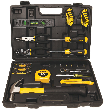Hanging Pictures with Style
Written by Lee Wyatt (last updated August 19, 2020)
For some reason, it can sometimes be a little difficult hanging pictures so that they look good. While everyone would like to start hanging pictures with style, it is not possible without first understanding the basics of the process. Listed here are some fairly simple guidelines that you can use to ensure that you are getting the best possible results with your picture hanging endeavors. As you get more familiar with the guidelines, you will be able to start experimenting more and more. This is fine, as long as you remember to keep the basic and fundamental guidelines in place.
- Never begin until you have a plan. Do not begin hanging any of your pictures until you have some plan in mind. Usually this can be done with the help of a simple piece of paper and a pen or pencil. Sketch out what you want to do, and where you would like to have your pictures placed. As you are doing this, make sure that you keep in mind the rest of the guidelines for hanging pictures with style.
- Keep things at eye level. Ideally, when you hang pictures, you should hang them at eye level. This does not meant that you hang the bottom or top of the picture at that level, but rather the center of the picture should be placed at eye level. This level will usually change depending on where you are placing the pictures, but remember that they should always be placed at eye level. For example, when you hang a picture in a hallway, or some other "standing" area, they should be placed at a height of about 54 inches; while in a "sitting" area the pictures should be placed at a height of about 48 inches.
- Large, empty spaces aren't good. One of the biggest mistakes that people make when hanging pictures is that they will leave large open spaces between, or around pictures. This is not good, and is a waste of space. Avoid empty space by keeping artwork and pictures proportional to the wall that they are on, as well as ensuring that large spaces are not left open. Instead of overcrowding a wall with pictures, "mask" the empty space by using a vase or other decorative object or even furniture to help take up the space. When using furniture, make sure that the pictures are not placed more than a foot above them, or you will find yourself with some noticeable empty space.
- Arrange pictures in a design. Try to arrange your pictures in a unified composition that provides an extra element of design. For example, you can place three separate pictures, which each have a different size of frame, into a general V-pattern. This same type of pattern can be used in conjunction with pictures, furniture, and other decorative objects as well.
Author Bio
Lee Wyatt
Contributor of numerous Tips.Net articles, Lee Wyatt is quickly becoming a regular "Jack of all trades." He is currently an independent contractor specializing in writing and editing. Contact him today for all of your writing and editing needs! Click here to contact. Learn more about Lee...
Installing Seat Covers
Seat covers are a great thing to get for your car or truck. They can protect the seats from rips, tears and spills and ...
Discover More
Making a Rain Barrel
One of the biggest expenses that any landscaper or gardener usually faces is the water bill. There are several ways that ...
Discover More
Using Roses in Landscaping
Roses are perhaps one of the most beloved, and improperly used, flowers around. There are all kinds of methods for using ...
Discover More
More Home Improvement Tips
Repairing Cracks in Plaster Walls
While plaster may be a very popular building material, it is also somewhat susceptible to cracks. If you don't take the ...
Discover More
Understanding Wallboard Finishing Levels
If you are thinking of having any type of wall work done in your home, then it is a good idea to understand the basics. ...
Discover More
Hanging Pictures on Masonry Walls
There are several areas of most homes that often go bare simply because we don't know how to hang pictures on them. ...
Discover More

Comments